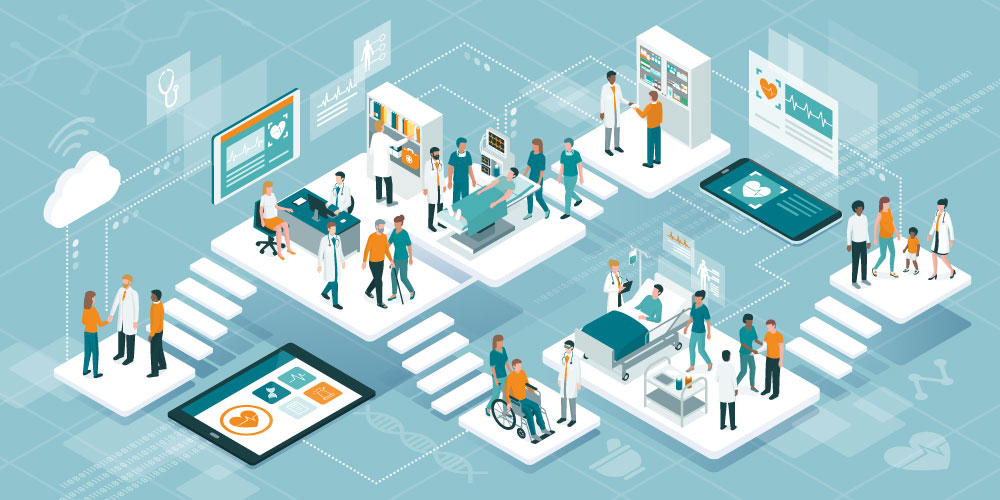Innovative Solutions in Healthcare Supply Chain

The healthcare industry, an intricate ecosystem comprised of medical professionals, patients, pharmaceuticals, medical equipment, and supplies, has always relied significantly on its supply chain to deliver essential care. However, in recent times, the dynamics of healthcare supply chains have undergone immense transformations, accentuated by technological advancements, global events, and changing patient needs. This article aims to delve into the future of healthcare supply chains, examining the current landscape, challenges, technological innovations, and potential trends that will shape the industry in the coming years.
Understanding the Complexity of Healthcare Supply Chain System
Comprehending the intricacies of the healthcare supply chain system is vital to grasping the behind-the-scenes operations within most healthcare frameworks. Typically, the significance of this system only comes to the forefront when disruptions occur.
The healthcare supply chain involves the processes of sourcing, procurement, storage, and distribution of these flow of medical products, equipment, and materials for patient care. Various stakeholders, including manufacturers, distributors, healthcare facilities, and regulatory bodies, play pivotal roles in the functioning of the healthcare supply chain. Healthcare providers heavily rely on the efficiency of this supply chain to ensure the availability of essential items for patient treatments and procedures.
The complexity of the healthcare supply chain is exacerbated by factors such as the diversity of products, varying demand patterns, stringent regulatory requirements, and the need for precise inventory management. Timely access to accurate and reliable data is essential for efficient decision-making and inventory optimization.
Challenges within the healthcare supply chain often revolve around issues of inventory management, demand forecasting, cost control, and maintaining product quality and safety standards. Shortages, stockouts, or disruptions in the supply chain can significantly impact patient care, causing delays or limitations in treatments.
According to recent research examining trends in the healthcare industry, a survey encompassing 400 nurses, physicians, service line leaders, and supply chain administrators revealed that over half (57%) of respondents could recall instances where physicians faced unavailability of necessary products for patient procedures. Beyond the clinical implications, the financial implications of the healthcare supply chain are substantial and continually escalating.
Even prior to the onset of the COVID-19 pandemic, a study indicated that supply expenses could constitute up to 40% of a hospital’s overall expenditures.
Efforts to improve the healthcare supply chain often involve adopting technological advancements, implementing robust inventory management systems, enhancing collaboration among stakeholders, and streamlining logistics and distribution processes. Solutions such as utilizing data analytics, implementing automation, and embracing innovative technologies like blockchain and artificial intelligence aim to enhance efficiency, transparency, and resilience within the supply chain.
Overall, understanding the healthcare supply chain system is crucial for healthcare organizations to navigate challenges, ensure the timely availability of essential medical supplies, and ultimately, provide optimal care to patients.
Key players in healthcare supply chain back office
Major stakeholders involved in the healthcare supply chain’s administrative domain extend beyond logistics, influencing the system and its associated expenditures. Here are several essential contributors operating behind the scenes:
Procure-to-pay (P2P): Engaging the procurement and accounts payable (AP) teams within healthcare organizations along with the accounts receivable (AR) teams of suppliers or distributors is crucial. This collaboration ensures alignment on product requisition, purchasing processes, and payment procedures.
Contracting: Collaboration among the healthcare organization’s internal contract management team, the group purchasing organization (GPO), distributors, and suppliers is pivotal. Establishing congruence on negotiated supply contracts, terms, and pricing contributes significantly to the streamlined functioning of the supply chain.
Consignment Products (e.g., implantable devices): Coordination between the healthcare organization’s clinical team and the sales team of suppliers is essential. Aligning efforts ensures the timely arrival of the required products in areas like the operating room (OR) for scheduled patient cases. Additionally, it guarantees adherence to contracted pricing terms during transactions with the supplier.
Healthcare supply chain challenges in 2023
When examining the healthcare industry’s supply chain as a cohesive “chain,” its vulnerabilities and obstacles become apparent. The process of moving a product from its manufacturing point to reaching the hands of a clinician involves the concerted efforts of multiple stakeholders, each performing their roles efficiently and competently.
Any gaps within the healthcare industry’s supply chain system elevate the risks related to product availability. These gaps can occur during various stages, starting from the production by the supplier, through the distribution to healthcare facilities, and then managed by the hospital supply chain and clinical staff, ultimately reaching the point of care at the patient’s bedside.
Challenges related to inventory management and distribution logistics, which were heightened during the COVID-19 pandemic, persist today. As of March 2023, the Health Industry Distributors Association (HIDA) highlighted that 93% of executives within healthcare provider organizations still report facing product shortages. They emphasized that these shortages are not only more prevalent than during the pandemic but are also increasingly challenging to anticipate or forecast.
Innovative in healthcare supply chains
Innovation within healthcare supply chains has become pivotal in shaping the industry’s evolution and efficiency. This realm encompasses the integration of advanced technologies, strategic management practices, and collaborative approaches to streamline processes, improve patient care, and optimize resource utilization.
Technology in healthcare supply chain management
Effective healthcare supply chain management hinges on two crucial elements: visibility and control. To optimize care and minimize expenses, healthcare institutions require access to precise, comprehensive, and actionable analytics regarding supply status—from the point of procurement to its utilization in patient care.
Current trends in the healthcare sector underscore the most impactful advancements in supply chain management, targeting operational and financial enhancements. Similar to various industries, healthcare is experiencing a digital revolution. According to the Harvard Business Review, “Digital transformation of the supply chain has proven to cut process costs by 50% and boost revenue by 20%, and hospitals are no exception.”
The migration of healthcare supply chain processes and data to cloud-based Enterprise Resource Planning (ERP) systems brings forth speed, flexibility, scalability, and enhanced visibility. Deloitte’s recent report in collaboration with Workday on the future of healthcare supply chains emphasized that “leaders seeking genuine control over their supply chains will increasingly rely on comprehensive upstream visibility facilitated by cloud-based management tools.”
The ongoing digital transformation is fueling increased process automation across the healthcare industry’s supply chain system, spanning from procurement to healthcare logistics. Employing a unified, ERP-integrated, cloud-based inventory management platform for digitizing and automating product tracking across this continuum empowers healthcare supply chain leaders to seize genuine control.
Innovative tech solutions in healthcare supply chains
The healthcare sector, with its complex and intricate supply chain, has recognized the transformative potential of innovation. Investments in cutting-edge solutions, such as advanced analytics, artificial intelligence (AI), Internet of Things (IoT), and blockchain, are revolutionizing traditional supply chain models. In a survey conducted by Gartner, 92% of healthcare chief information officers (CIO) indicated that artificial intelligence (AI) and machine learning (ML) are the top technologies expected to be adopted by 2025.
These innovations offer multifaceted benefits. They enhance transparency by providing real-time visibility into inventory levels, product movement, and supply status. This improved visibility enables healthcare organizations to mitigate risks associated with shortages, minimize waste, and ensure the timely availability of critical supplies.
The migration of healthcare supply chain processes to the cloud presents extensive opportunities for supply chain advancements, offering the potential to leverage digital technologies such as AI, ML, and blockchain.
Through the implementation of AI-enhanced inventory control and comprehensive supply chain management software and services, healthcare organizations have successfully identified errors, areas for enhanced efficiency, and potential risks to patient safety, such as recalled or expired products.
Moreover, innovative technologies aid in predictive analytics and demand forecasting, optimizing inventory management and reducing instances of stockouts or overstocking. AI-driven algorithms analyze vast datasets to predict demand patterns, enabling proactive decision-making and efficient allocation of resources.
Several instances demonstrate how AI-enhanced inventory management is driving advancements in the healthcare supply chain:
- Discovery of $51 million worth of inventory in a single facility, far exceeding the initial estimate of $5 million.
- Identification of nearly $200,000 worth of expired inventory within a 2,000-bed health system.
- Detection of a Schedule II controlled substance drug vial mistakenly mixed among non-controlled products in a storage area of a 700-bed hospital.
The implementation of blockchain technology ensures data integrity, security, and traceability across the supply chain network. It offers a tamper-proof system for recording transactions, reducing the risk of counterfeit products and enhancing trust among stakeholders.
Furthermore, the shift towards digital transformation is evident as healthcare supply chains embrace cloud-based solutions and integrated enterprise resource planning (ERP) systems. These platforms facilitate seamless data sharing, scalability, and flexibility, enabling swift adaptation to evolving demands and market fluctuations.
Future Trends in Supply Chain Management
Future trends in healthcare supply chain management are characterized by the leveraging of data and analytics, reinforced partnerships between suppliers and providers, a heightened focus on environmental sustainability, and a dedicated emphasis on health equity.
Leveraging Emerging Technologies
Regarding emerging technologies and their potential impact, healthcare executives prioritize investing in healthcare supply chain technologies that facilitate the creation of advanced and actionable analytics. In surveys of U.S. health system executives and supply chain leaders, robust data and analytics capabilities emerged as the top priority for future investments within the supply chain function.
To acquire valuable and trustworthy analytics essential for informed decision-making in healthcare supply chain operations, organizations must persist in investing in supply chain systems tailored for the healthcare industry. These systems should promote integration, automation, and collaboration among stakeholders. Cloud-based solutions, renowned for their adaptability and scalability, encompass these vital aspects, making them a preferred choice in addressing these requirements.
Collaborative Ecosystems
Collaboration among stakeholders is also integral to innovative supply chain management. Strategic partnerships between healthcare providers, suppliers, manufacturers, and technology firms foster innovation, co-creation, and the development of tailored solutions catering to specific industry needs. Opportunities for collaboration and innovation are set to shape the future landscape of the healthcare supply chain by fostering increased communication and cooperation among stakeholders within the sector.
Traditionally, the relationship between healthcare providers and suppliers has been lacking in transparency and open dialogue. This lack of communication hindered the sharing of critical healthcare supply chain data, impeding informed decision-making on both ends.
However, the COVID-19 pandemic necessitated a closer collaboration between providers and suppliers to ensure the uninterrupted flow of supplies despite numerous challenges. This necessity has triggered a shift in mindset. To fortify a more resilient healthcare supply chain comprehensively, stakeholders such as providers, suppliers, distributors, and other key players are recognizing the value of transparent communication and data sharing. Sharing information on inventory levels, shortages, forecasting, and demand has become imperative for the entire ecosystem.
Salil Joshi, a senior director and analyst at Gartner’s Supply Chain practice, outlines four steps that healthcare providers should take to fortify a resilient supply chain, emphasizing advancements in provider-supplier collaboration and innovation:
- Aggregate data from diverse sources to tackle inventory issues and optimize all supply chain functions. This involves enhancing data management systems, integrating data across supply chain and clinical systems, and fostering partnerships with solution providers, suppliers, and GPOs.
- Evaluate the strengths and weaknesses of information systems, implementing resilience capabilities for both supply chain and clinical systems. This assessment includes scrutinizing critical functionalities of ERP systems, inventory management systems, and EHR systems.
- Develop a comprehensive supply chain performance dashboard focusing on contracting, requisitioning, purchasing, inventory management, and supplier performance metrics.
- Establish collaboration tools with suppliers to exchange critical data, encompassing past purchase history, anticipated changes in demand, and enhanced inventory visibility.
Conclusion
The future of healthcare supply chains holds immense potential for transformation, driven by technological innovations and evolving trends. While challenges persist, the integration of advanced technologies, collaborative efforts, and a focus on resilience and adaptability will pave the way for more efficient, transparent, and patient-centric supply chains. Embracing these changes will be pivotal in ensuring the delivery of quality healthcare services to meet the evolving needs of patients and healthcare providers in the years to come.


